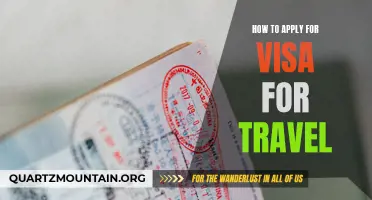
Peru, rich in history, culture, and natural wonders, has become an increasingly popular destination for international travelers. Whether you are planning a visit to the breathtaking Machu Picchu, exploring the vibrant city streets of Lima, or indulging in the culinary delights of Peruvian cuisine, understanding Peru's visa requirements is essential for a smooth and hassle-free trip. In this guide, we will delve into the different types of visa options available, the requirements for each, and provide essential tips for navigating the visa process in Peru. So, pack your bags and get ready to embark on a journey to one of South America's most captivating destinations!
What You'll Learn

Overview of Travel Requirements for Peru
If you're planning a trip to Peru, it's important to familiarize yourself with the country's travel requirements. Fortunately, most travelers can enter Peru without a visa, but there are a few things you'll need to keep in mind before you go.
First and foremost, you'll need a valid passport to enter Peru. Your passport should be valid for at least six months beyond the date of your arrival in the country. It's a good idea to make a photocopy of your passport and keep it in a safe place separate from your original document, just in case.
In terms of visas, Peru offers visa-free entry for citizens of many countries, including the United States, Canada, the United Kingdom, and most European Union countries. If you're a citizen of one of these countries, you can enter Peru as a tourist without a visa and stay for up to 183 days. This is more than enough time for most travelers.
However, if you're not a citizen of one of these visa-exempt countries, you will need to apply for a tourist visa before traveling to Peru. You can apply for a tourist visa at a Peruvian consulate or embassy in your home country. The requirements for obtaining a tourist visa may vary depending on your nationality, so it's best to contact the consulate or embassy well in advance to find out what documents you'll need to provide.
In addition to a valid passport and, if necessary, a tourist visa, there are a few other requirements you'll need to fulfill before entering Peru. First, you'll need to provide proof of onward travel. This means you'll need to show a return or onward ticket to a destination outside of Peru. This is to ensure that you don't intend to stay in the country indefinitely.
You may also be asked to show proof of sufficient funds to support yourself during your stay in Peru. This can include cash, traveler's checks, or a credit card. The amount of funds required may vary, but a general rule of thumb is to have enough money to cover your accommodation, transportation, and daily expenses.
It's also worth noting that Peru requires certain vaccinations for travelers entering the country. The most important of these is the yellow fever vaccine, which is recommended for all travelers visiting certain parts of the country, including the Amazon jungle. Other vaccines that may be recommended or required include typhoid, hepatitis A and B, and rabies. It's a good idea to consult with a travel health professional or your doctor before traveling to Peru to find out which vaccinations you may need.
In summary, most travelers can enter Peru without a visa, but a valid passport is required. If you're a citizen of a visa-exempt country, you can enter as a tourist and stay for up to 183 days. If you're not a citizen of a visa-exempt country, you'll need to apply for a tourist visa before traveling. Make sure to have proof of onward travel, sufficient funds, and any required vaccinations before entering Peru. By familiarizing yourself with these travel requirements, you can ensure a smooth and hassle-free trip to this beautiful and diverse country.
Understanding the Frequency of Travel with a US Visa
You may want to see also

Visa Exemptions for Certain Nationalities
Peru is a beautiful country located in South America and attracts travelers from around the world with its stunning landscapes, ancient ruins, and vibrant culture. If you are planning to visit Peru, you may be wondering whether you need a visa to enter the country. Fortunately, Peru offers visa exemptions for certain nationalities, making it easier for travelers to explore this fascinating destination.
Here are some key details about visa exemptions for Peru:
Visa Exemptions based on Nationality:
Peru has established visa exemptions for citizens of several countries. These exemptions allow eligible nationals to enter Peru without a visa and stay for a specified period. The duration of the visa exemption varies depending on the nationality and the purpose of the visit. It is important to note that the visa exemption is not equivalent to a visa, but rather allows entry to the country without obtaining a separate visa in advance. However, travelers must still comply with the immigration requirements upon arrival.
Visa Exemption for Tourism:
If you are visiting Peru for tourism purposes, you may be eligible for a visa exemption. Citizens from many countries, including the United States, Canada, the United Kingdom, Australia, and most European Union member states, can enter Peru as tourists without a visa. The usual duration of stay under this exemption is 90 days, which can be extended for an additional 90 days upon request.
Visa Exemption for Business and Work:
Peru also offers visa exemptions for certain nationalities for business-related activities or work purposes. This exemption is typically applicable for short-term business trips, meetings, negotiations, or participation in conferences or events. The duration of stay under this exemption is usually limited to 90 days within a 365-day period. It is important to note that engaging in paid work or employment under this visa exemption is not permitted, and a separate work visa is required.
Visa Exemption for Diplomatic and Official Passport Holders:
Diplomatic and official passport holders from several countries are eligible for visa exemptions when traveling to Peru for official purposes. These exemptions usually allow for a 90-day stay, but it is recommended to check with the Peruvian Embassy or Consulate in your country for specific requirements and restrictions.
Visa Exemption for Transiting Passengers:
If you are transiting through Peru to a final destination, you may be eligible for a visa exemption, provided you meet certain conditions. The duration of stay under this exemption is limited to 24 hours, and travelers must hold valid onward tickets and relevant documents for their final destination.
It is important to note that the information provided here is general, and visa requirements may vary for certain nationalities or circumstances. To ensure a smooth and hassle-free travel experience, it is always recommended to check the latest visa requirements and exemptions specific to your nationality and purpose of visit. You can consult the Peruvian Embassy or Consulate in your country or refer to official government websites for up-to-date information.
Travelers should also have a valid passport with at least six months of remaining validity and comply with other immigration requirements, such as proof of sufficient funds, accommodation arrangements, and return or onward travel tickets.
In conclusion, if you are planning to travel to Peru, it is good news that the country offers visa exemptions for citizens of certain nationalities. Whether you are traveling for tourism, business, or official purposes, make sure to check the specific visa requirements and exemptions applicable to you. With the right documentation and preparation, you can enjoy a memorable trip to Peru and explore its rich history, natural wonders, and cultural attractions.
Exploring Canadian Adventures: Can I Travel to Canada on a J1 Visa?
You may want to see also

Visa Application Process for Traveling to Peru
If you are planning a trip to Peru, it is important to know whether or not you need a visa to enter the country. Generally, most visitors to Peru do not require a visa for tourism or business purposes. However, it is always advisable to check the latest visa regulations before you travel, as requirements can change.
Visa Exemption:
Citizens of many countries are exempt from obtaining a visa to enter Peru. This means that they can enter the country for tourism or business purposes and stay for up to 90 days without a visa. Some of the countries whose citizens do not require a visa for Peru include the United States, Canada, United Kingdom, Australia, New Zealand, Schengen Area countries, and most countries in South America.
Length of Stay:
As mentioned earlier, visa-exempt visitors can stay in Peru for up to 90 days. This period starts from the day of entry, and it is important to ensure that you do not overstay your permitted time. If you wish to stay in Peru for longer than 90 days, you will need to apply for a visa extension before your initial 90-day period expires.
Visa for Specific Purposes:
In some cases, you may require a visa even if your country is visa-exempt. This is usually the case if you are planning to visit Peru for a specific purpose such as work, study, or volunteering. In such cases, you will need to apply for a visa before you travel. The specific requirements and application process will vary depending on the purpose of your visit, so it is advisable to check with the Peruvian embassy or consulate in your country for detailed instructions.
Visa Application Process:
If you do require a visa, the application process for traveling to Peru is generally straightforward. Here are the basic steps to follow:
- Check the requirements: Start by checking the visa requirements for your specific situation. This may include completing an application form, providing supporting documents such as a valid passport, proof of accommodation in Peru, proof of sufficient funds, and a return ticket.
- Make an appointment: Once you have gathered all the necessary documents, make an appointment at the nearest Peruvian embassy or consulate to submit your application. Some countries may also allow for online visa applications, so check if this option is available.
- Submit your application: On the day of your appointment, bring all the required documents and submit your application. Depending on the embassy or consulate, you may also need to pay a visa fee at this time.
- Wait for processing: After submitting your application, you will need to wait for it to be processed. The processing time can vary depending on the embassy or consulate, so it is advisable to apply well in advance of your planned travel dates.
- Collect your visa: Once your application has been approved, you will be notified to collect your visa. This may require another visit to the embassy or consulate, or the visa may be sent to you by mail or courier service.
It is important to note that the requirements and visa application process may vary slightly depending on your country of citizenship, so it is advisable to check the specific instructions provided by the Peruvian embassy or consulate in your country. By being informed and prepared, you can ensure a smooth visa application process and enjoy your trip to Peru without any issues.
Visa Requirements for Americans Traveling to Japan
You may want to see also

Important Documents and Information Needed for Obtaining a Visa
If you are planning to travel to Peru, it is important to check whether you need a visa to enter the country. Peru has a visa policy that varies depending on the nationality of the traveler. In this article, we will provide you with important information about the documents and requirements needed to obtain a visa for Peru.
Firstly, it is crucial to determine whether you require a visa or if you can enter Peru without one. Citizens of certain countries are exempt from obtaining a visa for tourism or business purposes, and are granted a stay of up to 183 days. These countries include the United States, Canada, the United Kingdom, Australia, New Zealand, and most European Union member states. However, it is important to note that the length of stay can vary and it is advisable to check with the nearest Peruvian embassy or consulate for the most up-to-date information.
If you are not a citizen of one of the exempt countries, you will need to obtain a visa before traveling to Peru. The first step is to contact the nearest Peruvian embassy or consulate in your country to inquire about the visa application process and requirements. In general, the following documents and information are commonly required:
- Passport: You must have a valid passport with at least six months of remaining validity from the date of entry into Peru. It is recommended to have a photocopy of the passport as well.
- Visa application form: You will need to complete a visa application form provided by the Peruvian embassy or consulate. The form usually requires personal information such as your full name, address, contact details, and purpose of the trip.
- Two recent passport-sized photographs: These photographs should meet the specific requirements of the Peruvian embassy or consulate, such as size and background color.
- Flight itinerary: You will need to provide a copy of your round-trip flight itinerary. This should include your arrival and departure dates, as well as the name of the airline and flight numbers.
- Proof of accommodation: It is important to show proof of your accommodation in Peru, such as hotel reservations or an invitation letter from a host if you are staying with friends or family.
- Financial evidence: You may be required to provide evidence of your financial ability to cover your expenses during your stay in Peru. This can include bank statements, credit card statements, or proof of employment.
- Travel insurance: It is recommended to have travel insurance that covers medical expenses and emergency evacuation. Some embassies may require proof of travel insurance as part of the visa application.
- Additional documents: Depending on the purpose of your trip, you may need to provide additional documents. For example, if you are traveling for business purposes, you may need a letter from your employer stating the purpose of your trip and confirming your employment status.
It is important to note that the visa application process can vary depending on the embassy or consulate that you are applying through. Therefore, it is advisable to contact the nearest Peruvian embassy or consulate well in advance to check the specific requirements and procedures.
In conclusion, if you are planning to travel to Peru, it is essential to determine whether you need a visa or if you are exempt. If a visa is required, make sure to gather all the necessary documents and information mentioned above. By being well-prepared, you can ensure a smooth and hassle-free visa application process for your trip to Peru.
Exploring Chile: Visa Requirements for Australian Travelers
You may want to see also
Frequently asked questions
Yes, most travelers to Peru require a visa. However, some nationalities are exempt from visa requirements for short stays.
To apply for a visa to travel to Peru, you would need to contact the nearest Peruvian embassy or consulate in your country or region.
The visa processing time for Peru can vary depending on your nationality and the specific type of visa you are applying for. It is advisable to apply well in advance of your planned travel dates.
The specific documents required for a visa to Peru can vary depending on your nationality and the type of visa you are applying for. Generally, you would need a valid passport, completed application form, proof of travel itinerary, proof of accommodation, financial documents, and a passport-sized photograph.
No, Peru does not offer visas on arrival. It is necessary to apply for a visa before traveling to Peru.







